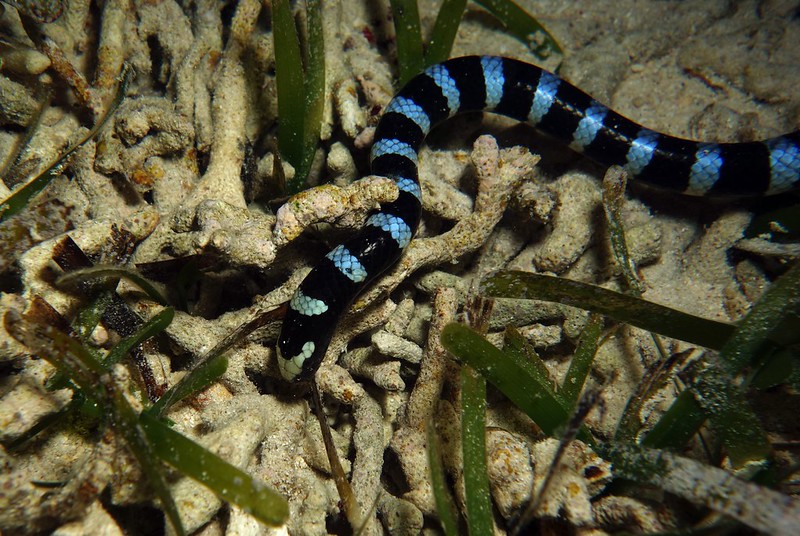
Blue-lipped sea krait Facts
- The most often employed common name for this colorful product of marine evolution is the highly descriptive term of Blue-lipped sea krait. It has a few others, too, though. Those include the similar titles common sea krait and blue-banded sea krait.
- Within the halls of science, however, it’s possibly better known by its technical moniker. That term, though, is somewhat difficult for the layperson to pronounce. That’s because this marvel of Nature bears the challenging tag Laticauda laticaudata.
- The eminent Swedish zoologist Carl Linnaeus accomplished the first acknowledgement of the marine reptile as a separate and distinct species, in 1758. Yet, he assigned the animal a name different than this one. He applied the epithet of Coluber laticaudatus.
- During various periods of subsequent research, though, other experts later renamed the amazing species. That process, in fact, occurred several times in the intervening years. This happens often, due to ongoing studies and new scientific findings.
- Fortunately, the intriguing Blue-lipped sea krait appears to still be maintaining both a stable and sufficient population base. That pleasant state alaso seems to extend throughout its native range. The IUCN thus currently lists the animal as Least Concern.
- It nevertheless still faces the same potential threats to its continued existence as all forms of life on this planet. Most of those stem for the actions of mankind. These include the closely related perils of habitat loss and climate change, among others.
Related Articles
Blue-lipped sea krait Physical Description
The aptly-named Blue-lipped sea krait typically captures the attention of those who encounter it. That’s partly due to its venomous nature, of course, but not solely. The fascinating species also earns a portion of appreciation for its very distinctive attributes.
In terms of various such qualities, it follows a pattern common among many animals. That’s in the fact that it displays a certain degree of the physiological characteristic of sexual dimorphism. In this reptile, though, that trait manifests in both size and number of scales.
Females attain a greater average body length than their male counterparts. For them, this specific aspect measures approximately 42 in (1.07 m). The males, meanwhile, reach only slightly shorter lengths. They grow to a mean length equaling roughly 36 in (0.91 m).
The other gender-based difference in the Blue-lipped sea krait occurs in the scales. On the underside of the creature, males develop 38 – 47 of these. The females, though, display fewer. For them, these features only average between 30 – 35. Exceptions do happen, though.
Otherwise, the two sexes present the same overall appearance to the observer. This consists of a striking alternating pattern of large black and blue bands. Despite the name, however, the upper lip shows a light brown shade. The reptile also has a flattened tip to its tail.
- Kingdom: Animalia
- Phylum: Chordata
- Class: Reptilia
- Order: Squamata
- Family: Elapidae
- Genus: Laticauda
- Species: L. laticaudata
Blue-lipped sea krait Distribution, Habitat, and Ecology
The lovely Blue-lipped sea krait evolved as native to a comparatively broad swathe of the marine regions of the globe. The full extent of that zone of habitation might come as a surprise to some people, though. In fact, it’s range is greater than many of its relatives.
It’s common in both the Indian Ocean, and the western portion of Pacific Ocean. It’s also frequently seen in areas near or around such locations as Japan, Taiwan, and the Philippines. The reptile is also ofen found around Australia and New Caledonia, to name a few places.
The creature displays an impressive flexibiltiy regarding its choice of habitat. That’s because, within its range, it appears in tropical, subtropical, and temperate waters alike. This high degree of adaptability serves as an important evolutionary advantage for the species.
In all regions it appears in, however, the marine reptile does show favoritism for several various types of ecosystems. The settings include beds of seagrass, coastal estuaries, and lagoons. Yet, its most highly preferred area of residence seems to consist of coral reefs.
The incredible Blue-lipped sea krait additionally evolved as mainly nocturnal in nature. During the day, it usually conceals itself beneath coral reefs and similar structures. At night, though, it emerges to hunt. It principally consumes various species of small fish and eels.
Interestingly, despite living in the sea, the animal leaves those confines to mate on land. Later, the female returns to land to lay her eggs. These typically number 1 -7 in total. She generally lays them rock crevices or caves. Once hatched, the young immediately seek water.
Species Sharing Its Range
Fin Whale
Check out our other articles on 3 Surprising Sahara Desert Sites, Grizzled Giant Squirrel, Okefenokee Swamp, Great Rhododendron, Indian Vulture, East African Lowland Honey Bee
